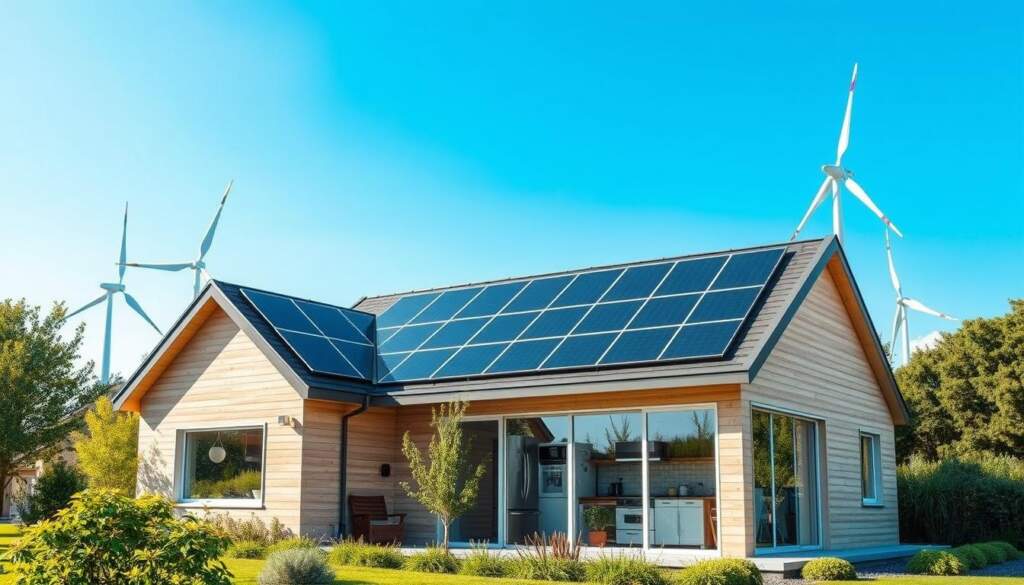Embarking on the journey towards green living begins with understanding that every aspect of our daily existence—from the food we eat to the products we buy—carries an environmental weight. The quest for an eco-friendly lifestyle is a commitment to conscious choices that aim for environmental impact reduction and carbon footprint minimization. Reflecting on the unsettling statistic that 335 million metric tons of plastic are churned out year over year, with a staggering 50% marked for short-lived use before polluting landfills or precious oceans1, propels us toward adopting sustainable living tips in our routine. Integrating practices such as recycling, using reusable water bottles, and swapping to plant-based diets can lead to a massive 73% reduction in personal carbon footprint1. With the U.S. wasting 30 to 40% of its food supply1, honoring our resources and curbing waste becomes not just an individual, but a collective priority for a healthier planet.
Key Takeaways
- Single-use plastics are a significant contributor to landfill and ocean waste1.
- Dietary changes, like adopting a vegetarian or vegan lifestyle, can lower carbon footprints significantly1.
- Food waste management is crucial, with a substantial portion of the U.S. food supply being wasted annually1.
- Simple home energy conservation methods can tackle over 20% of U.S. emissions1.
- Supporting sustainable businesses and eco-friendly policies promotes broader environmental advances1.
- Every small, eco-friendly habit can contribute to a major global impact on environmental conservation1.
Understanding Your Carbon Footprint and Its Impact
The concept of a carbon footprint plays a crucial role in tackling climate change mitigation efforts and fostering eco-conscious decision-making. As we delve deeper into the meaning and significance of this environmental indicator, it’s essential to appreciate how our daily actions contribute to our overall environmental impact.
What is a Carbon Footprint?
A carbon footprint represents the total amount of personal greenhouse gas emissions produced by individual actions, from the car you drive to the energy used to heat your home. Effective carbon footprint calculation offers a quantifiable measure of how each of us contributes to global warming, paving the way for targeted strategies to combat climate change. A crucial metric is the global average carbon footprint, which stands around 4 tons per person, starkly contrasting with an average of 16 tons per U.S. citizen2.
How Daily Choices Influence Our Personal Carbon Emissions
Everyday decisions, whether it’s choosing to drive less or switching to renewable energy, can significantly affect our personal carbon emissions. For instance, opting for a train over a plane can dramatically reduce your travel-related emissions, as planes emit an astonishing 285g of carbon per kilometer, compared to just 14g for trains3. Similarly, adopting energy-efficient appliances and reducing meat consumption can lead to notable declines in our carbon output.
The Collective Power of Individual Actions
The path towards climate change mitigation is not solely in the hands of policymakers or large corporations. Rather, it is a collective endeavor that requires the effort of every individual. Transitioning to 100% renewable energy and making dietary changes are prime examples of how substantial changes can arise from individual decisions. Thus, by integrating small, sustainable choices into our lifestyles, we can collectively steer towards a more sustainable future with reduced carbon footprints2.
As we move forward, understanding and reducing our carbon footprint is not just beneficial for our environments but is a critical step towards ensuring a viable future for subsequent generations. By employing better carbon footprint calculation methods and making informed choices, we can each contribute to the grand scheme of environmental stewardship and climate resilience.
| Activity | Carbon Emissions |
|---|---|
| Air Travel (per km) | 285g3 |
| Car Travel (per km) | 104g3 |
| Train Travel (per km) | 14g3 |
Embracing eco-conscious decision-making in our daily lives not only assists in climate change mitigation but also sets a precedent for future generations to lead a more environmentally friendly lifestyle.
Practical Steps Towards a Greener Daily Life
Embracing eco-friendly daily routine and sustainable living practices is more achievable than many might think. Simple changes in our everyday behavior can significantly impact our environment. One of the most straightforward shifts is in our choice of lighting: replacing incandescent bulbs with LEDs can drastically reduce electricity use, as 90% of the electricity used by conventional bulbs is lost as heat, while LEDs use as little as 20%4.
- Temperature adjustments: Simply adjusting your thermostat by 7 to 10 degrees for eight hours each day could lead to a 10% savings on your annual energy bill4.
- Smart food choices: Opting for a plant-based diet over beef can significantly decrease water usage and methane emissions, as the production of a single quarter-pound burger requires 460 gallons of water and emits 0.126 pounds of methane4. Furthermore, if you switch from red meat to chicken, you can reduce your annual carbon footprint by approximately 882lbs5.
- Reducing electronic waste: Unplugging devices when not in use can cut down standby power consumption that accounts for almost 10% of the energy bill4.
Moreover, energy conservation measures extend to transportation choices. Biking to work even just one day a week can reduce your emissions for that week by a minimum of 20%4. Coupled with the decision to take stairs over elevators, these are easy ways to forge climate-positive habits in daily travel.


While waste reduction strategies are fundamental, managing food output significantly lowers global warming impacts because trashed food in landfills emits methane, a potent greenhouse gas4. In the U.S., about 40% of edible food is wasted by consumers alone, which also adds to unnecessary carbon emissions6.
Enhancing the sustainability of your household isn’t limited to energy and food. Installing a solar panel system can cut up to 1.6 tons of carbon emissions annually from your household4. Moreover, supporting sustainable businesses and using sustainable cleaning products can further solidify eco-friendly daily routines.
Every step taken towards a sustainable lifestyle not only aids in conserving energy but also promotes a healthier planet, fostering a cycle of positive change that benefits both the environment and our quality of life.
Adopting Renewable Energy and Efficient Home Systems
Embarking on a journey toward sustainability involves integrating renewable energy adoption and energy-efficient home systems into our daily lives. As the necessity for eco-conscious living intensifies, the choices we make at home play a pivotal role in shaping a sustainable future.
Gardening: Growing Your Own Food for a Lower Carbon Impact
Home gardening benefits more than just your diet; it significantly reduces the carbon footprint associated with transporting produce. Commercially-grown produce often travels thousands of miles before reaching consumers, highlighting the stark environmental impact of food transportation7. Growing your own food not only offers the freshest of ingredients but also contributes to a healthier planet by minimizing travel miles and reducing the use of plastics, typically involved in packaging processes where about 40 percent of all plastic produced is utilized7.
From Diet to Travel: Making Eco-Friendly Choices
Making eco-friendly dietary and travel choices is crucial in fostering a sustainable lifestyle. Opting for a plant-based diet for at least half the time can reduce greenhouse gas emissions from diets by up to 35 percent in the US7. Meanwhile, sustainable travel choices like carpooling or choosing walking and cycling over driving can dramatically decrease carbon footprints. Incorporating such habits ensures our travel decisions align firmly with ongoing environmental conservation efforts.
Integrating Renewable Energies and Efficient Systems in Homes
The adoption of solar panels, especially in sun-rich states like Texas and Louisiana, presents an excellent opportunity for leveraging renewable energy resources8. Furthermore, installing energy-efficient appliances and smart thermostats in our homes can significantly cut down energy usage and utility costs in these regions8. High-efficiency systems such as low-flow fixtures and rainwater harvesting not only conserve essential resources but also support comprehensive environmental conservation efforts8.


Being aware of the significant impact our home and lifestyle choices have on the environment compels us to adopt more sustainable practices. Every small adjustment towards renewable energy adoption, including choosing energy-efficient home systems, nourishing home gardens, making eco-friendly travel and diet decisions, resonate profoundly with ongoing global sustainability efforts, securing a greener tomorrow.
| Eco-Friendly Practice | Benefits | Carbon Savings |
|---|---|---|
| Plant-based diet (50% Adoption) | Reduces dependency on animal farming | 35% reduction in GHG emissions7 |
| Rainwater harvesting | Conserves water; Reduces runoff | Varies by region8 |
| High-efficiency home heating | Lower energy consumption | Reduces 13-14% of UK’s carbon emissions from heating9 |
| Use of energy-efficient LEDs | Long-lasting; Consumes less power | Significant reductions over traditional bulbs8 |
Conclusion
As we face the challenges of accelerated climate change, the importance of a sustainable lifestyle adoption has never been more pronounced10. Embracing positive environmental practices in our daily lives, from choosing plant-based diets to reduce our carbon footprint10 to installing energy-efficient solutions like solar panels10, we make a substantial contribution towards a greener future. Cultivating such habits reflects not only personal responsibility but also strengthens the collective climate action contribution that can drive significant environmental progress10.
By making informed choices, such as utilizing green transportation options10, supporting companies with sustainable certifications10, and engaging in waste-lowering initiatives like composting10, we can actively participate in the global movement towards green living. These efforts, complemented by practical strategies outlined in recent surveys, such as educating stakeholders on the benefits of sustainability11, show a promising trend in the right direction. The drive towards sustainability equates to embracing a culture that values the long-term health and balance of our planet, which can lead to cost savings and enhanced reputations for individuals and organizations alike1011.
Our collective actions culminate in a powerful green living conclusion: by adopting eco-friendly practices and technologies, we contribute to a sustainable and equitable world10. Whether it’s through conservation initiatives, such as effective water use10, or by planting trees to absorb carbon dioxide10, each choice we make is a step toward reversing the adverse effects of climate change. The journey towards a greener planet is ongoing, but with each individual and community effort, we foster a healthier environment for generations to come.
FAQ
How can I start living more sustainably?
What is a carbon footprint?
How do my daily choices influence my personal carbon emissions?
Can individual actions really help combat climate change?
What are some practical steps I can take to live greener every day?
Why is gardening beneficial for a sustainable lifestyle?
What should I consider in my diet and travel to be more eco-friendly?
How can adopting renewable energy and efficient home systems contribute to a sustainable lifestyle?
Source Links
- Go Green: 10 Tips for a More Sustainable Lifestyle | Appalachian Mountain Club (AMC) – https://www.outdoors.org/resources/amc-outdoors/conservation-and-climate/go-green-10-tips-for-a-more-sustainable-lifestyle/
- Carbon Footprint: Understanding and Reducing Environmental Impact – https://medium.com/@cinthia.cicilio/carbon-footprint-understanding-and-reducing-environmental-impact-f7ba91f7646a
- How to reduce my carbon footprint? | European Youth Portal – https://youth.europa.eu/get-involved/sustainable-development/how-reduce-my-carbon-footprint_en
- Sustainable Living Tips – https://www.conservation.org/act/sustainable-living-tips
- 14 Easy Ways to Be More Sustainable in 2023 | Move For Hunger – https://moveforhunger.org/blog/easy-ways-be-more-sustainable-2023
- Eight simple things you can do for the environment – https://news.stanford.edu/stories/2024/01/eight-simple-meaningful-eco-friendly-actions-can-incorporate-life
- 12 Sustainable Practices You Can Do at Home – https://theearthlingco.com/blogs/news/sustainable-practices-at-home
- Sustainable Living in a Tiny Home: Eco-friendly & Energy-efficient Solutions – https://www.saddlebrookelife.com/blog/sustainable-living-in-a-tiny-home
- The Ultimate 20 step Guide to Eco-friendly Living | Good Energy – https://www.goodenergy.co.uk/blog/the-ultimate-20-step-guide-to-eco-friendly-living/
- The Key to Sustainable Living: Embracing an Eco-Friendly Lifestyle in 2024 – https://www.linkedin.com/pulse/key-sustainable-living-embracing-eco-friendly-lifestyle-saqib-ali
- Sustainability in Events: Strategies for Reducing Waste and Promoting Eco-Friendly Practices – Personify – https://personifycorp.com/blog/sustainability-in-events/


